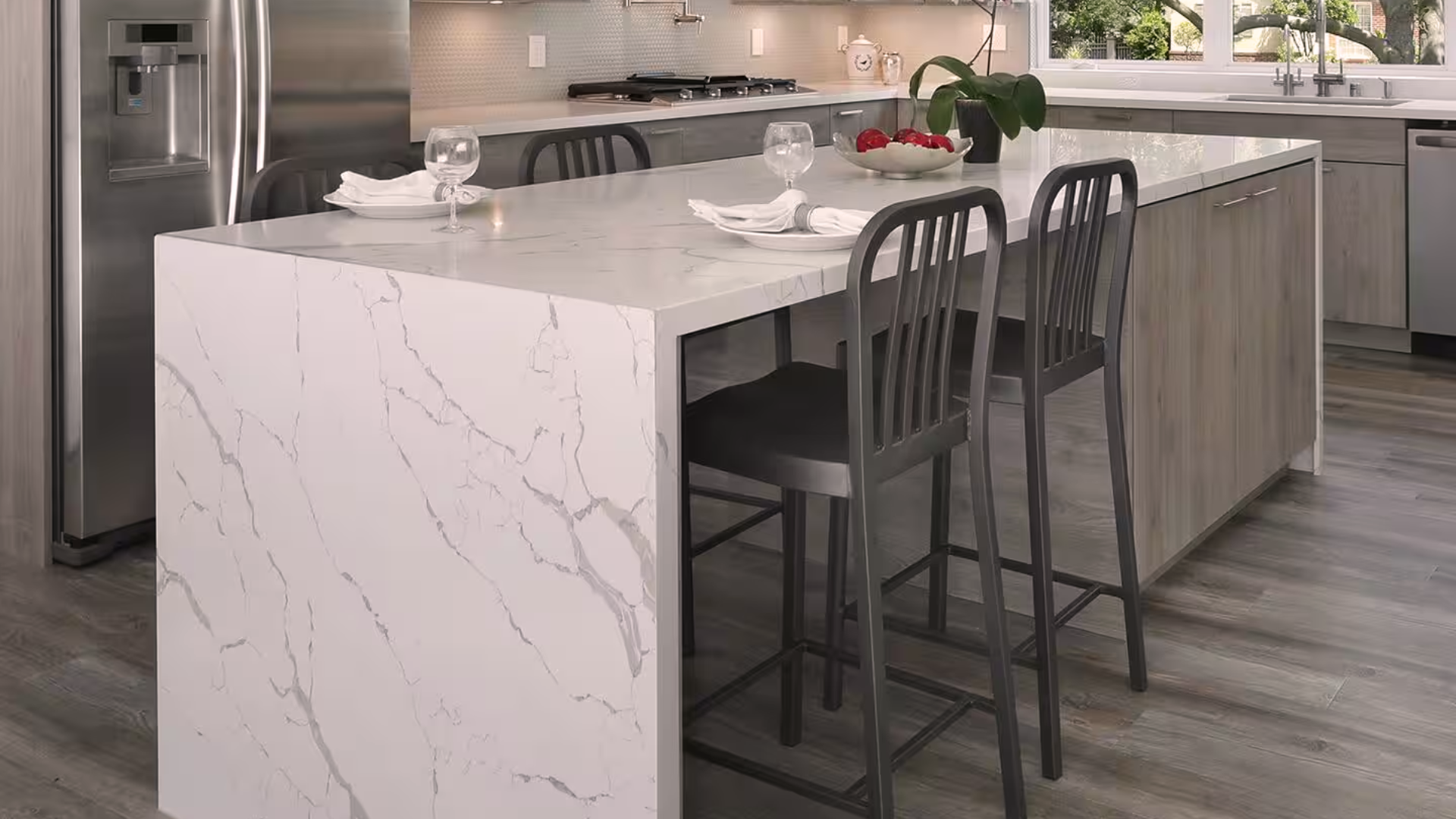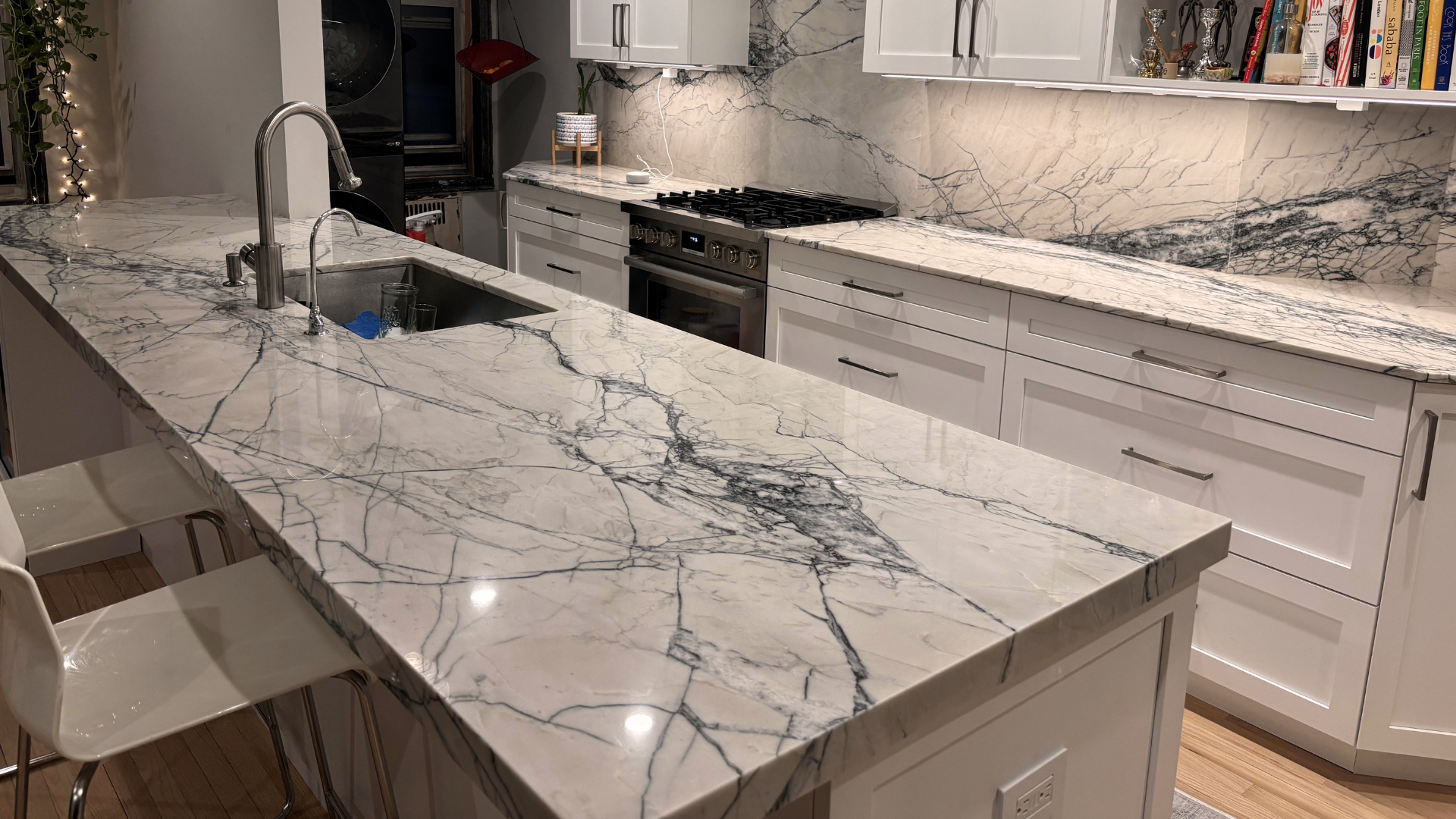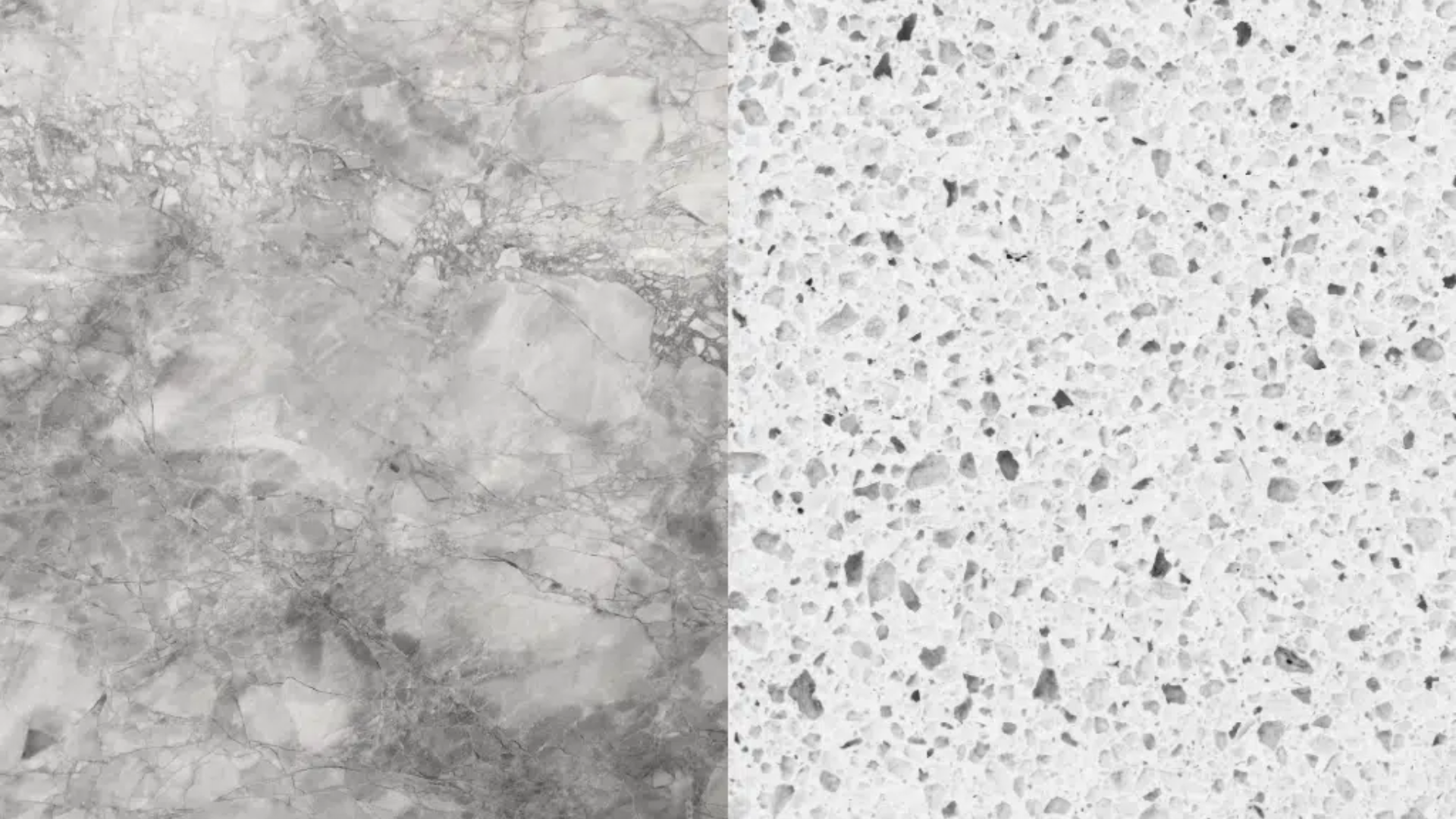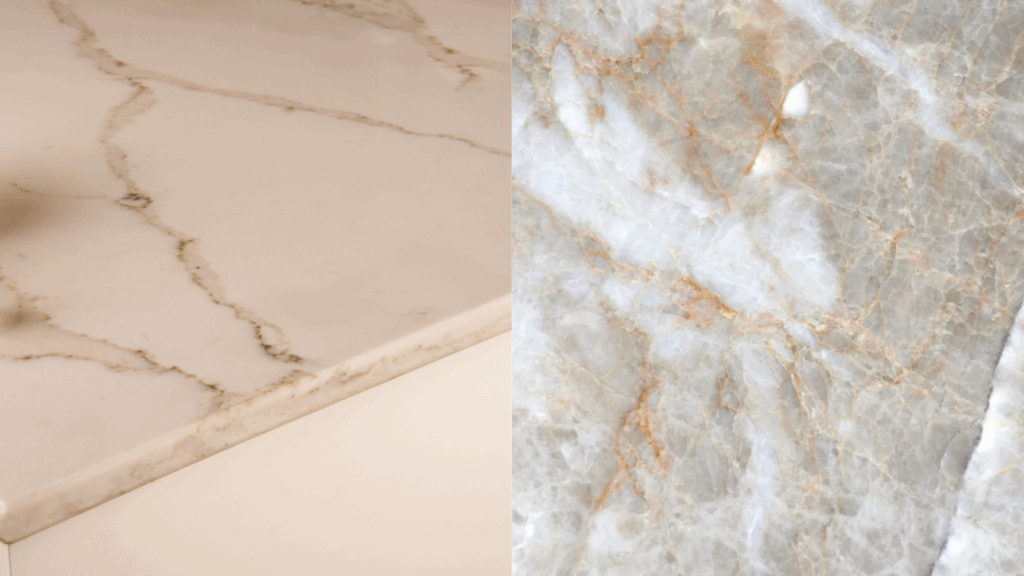Ever found yourself standing in a home improvement store, completely confused by two seemingly identical materials? You’re not alone.
As you plan your kitchen or bathroom remodel, you’ve probably heard the words “quartz” and “quartzite” tossed around, and they sound almost the same.
Let’s be real: These materials look so similar that even experienced designers sometimes mix them up. They’re actually quite different when it comes to:
- Cost
- Durability
- Maintenance
- Style
I’ll break down everything you need to know in simple terms. By the end, you’ll be able to choose the perfect surface for your home with confidence. Let’s get started!
What Is Quartz?

Quartz is a man-made surface made from crushed stone and resin.
It’s built in a factory to look smooth and clean, with colors and patterns that remain consistent from one slab to another.
Many people like quartz because it’s strong, doesn’t need sealing, and is easy to keep clean.
It’s a great choice for busy kitchens and bathrooms where you want a modern, low-maintenance look
Manufacturers can tweak colors, add sparkles, or create patterns that mimic the appearance of natural stone. Your kitchen could have a surface that looks like:
- Sleek concrete
- Luxurious marble
- Rustic granite
- Midnight black
- Ocean blue
However, what makes quartz a kitchen superhero is its non-porous surface. Unlike other countertops that soak up spills like a sponge, quartz stands its ground.
Tomato sauce? Wine? No problem. Just wipe it clean. No sealing, no special treatments needed.
What Is Quartzite?

Quartzite is a natural stone that forms when sandstone is pressed under heat and pressure deep in the earth.
This process makes it very strong and hard, even harder than granite. Each piece of quartzite is unique, with beautiful colors and patterns made by nature.
It’s a popular choice for countertops because it resembles marble but is more durable. Quartzite needs sealing to protect it, but with care, it can last for many years
Most quartzite comes in lighter, more natural tones:
- Soft whites
- Creamy beiges
- Subtle grays
- Gentle earth tones
Want to know something cool? The change from sandstone to quartzite happens under such intense pressure that individual sand grains actually melt and recrystallize. Mother Nature’s makeover, if you ask me.
Key Differences Between Quartz and Quartzite

Choosing between quartz and quartzite can be a challenging decision. This comparison breaks down the essential distinctions to help you make an informed decision about your countertop material.
1. Appearance: Predictable vs. Unpredictable
Quartz is the chameleon of countertop materials. I love how manufacturers can create almost any look you want. It’s like having a design wizard at your fingertips.
The surface comes out uniform, smooth, and exactly as you planned. Want a marble look without the drama? Quartz delivers.
Quartzite tells a natural story. Each slab is a unique masterpiece straight from the earth. No two pieces look exactly alike. It’s like having a piece of geological art in your kitchen.
The natural veining and subtle color variations create a one-of-a-kind canvas that no manufactured material can truly replicate.
2. Durability: Strength Meets Performance
Quartz brings consistent strength to the table. Manufacturers design it to be tough, resistant to chips and cracks. It’s reliable, like a dependable friend who always shows up.
But it has limits. High heat can damage the resin that holds it together.
Quartzite is nature’s tank. Formed under extreme pressure, it’s incredibly hard and resistant. You can place a hot pan directly on the surface, quartzite handles heat very well.
3. Maintenance: Effort vs. Ease
Quartz is the low-maintenance superstar. I’m all about surfaces that make life easier. No sealing required. Spills wipe away like magic.
Its non-porous surface means bacteria and stains don’t stand a chance. Clean it with soap and water, and you’re done.
Quartzite demands a bit more attention. You’ll need to seal it regularly to protect its beautiful surface. It’s more porous, which means it can absorb stains if you’re not careful.
4. Cost: Budget Matters
Quartz offers predictable pricing. Manufacturers control the production, so costs remain relatively stable.
You’ll find options at various price points, making it budget-friendly for many homeowners.
Quartzite can be the luxury sports car of countertops. Prices fluctuate based on rarity, supply, and demand.
Some quartzite slabs can be expensive because of their unique colors and patterns. They’re like natural artwork from the earth, beautiful, but not always budget-friendly.
5. UV and Heat Resistance
Quartz has a kryptonite: sunlight. Extended UV exposure can cause discoloration. It’s not ideal for outdoor kitchens or super-sunny spaces. Indoor use? Absolutely perfect.
Quartzite holds up well in sunlight. Its natural makeup makes it a great choice for outdoor kitchens, bright rooms, and areas with strong light.
It won’t fade or lose its color, even with regular sun exposure. If you’re planning an outdoor cooking space, quartzite is a strong and reliable option.
6. Stain Resistance: The Spill Test
Quartz wins the stain-resistance championship. Its non-porous surface means most spills sit on top, waiting to be wiped away. Red wine? Tomato sauce? No problem.
Quartzite requires more defense. Without proper sealing, it can absorb stains like a sponge. It’s got natural beauty, but you’ll need to be more careful and quick with cleanup.
Pros and Cons of Quartz
Quartz countertops are engineered stone surfaces that offer a mix of beauty, durability, and practicality. Let’s see a breakdown of what makes them shine and where they might fall short.
| Feature | Pros | Cons |
|---|---|---|
| Design Flexibility | Endless color options! Create your dream look with custom designs that match any style. | Lacks the natural stone’s unique character – feels a bit too perfect |
| Maintenance | Zero effort cleaning. Wipe and go. No sealing required. | Sensitive to extreme conditions – hot pans and direct sunlight can damage |
| Durability | Tough surface resists scratches and stains like a champ. | Not as heat-resistant as natural stone alternatives |
| Cost | Budget-friendly with consistent pricing across styles. | It may look less premium compared to natural stone |
| Performance | Non-porous surface keeps bacteria and stains away. | Color can fade in sunny spots over time |
Pro tip: Quartz is a dependable choice for countertops. It may not have bold patterns, but it’s strong, easy to care for, and always looks good. Just remember, don’t place hot pans directly on it, and try to keep it out of direct sunlight to avoid damage over time.
Pros and Cons of Quartzite
Quartzite is a natural stone formed through intense geological processes, offering unique beauty and exceptional durability. Learn its strengths and potential challenges below.
| Feature | Pros | Cons |
|---|---|---|
| Natural Beauty | Earth’s artwork – each slab tells a unique story with beautiful veining and patterns | Limited color palette – mostly whites and soft neutrals |
| Durability | Tough as rocks (literally). Handles heat like a pro, resists scratches effortlessly | Requires more maintenance – needs regular sealing to protect its surface |
| Design Impact | Perfect for high-end kitchens. Creates a classy look | Installation can be tricky – harder to cut, which means higher labor costs |
| Performance | Withstands high temperatures without breaking a sweat | More expensive than manufactured alternatives |
| Longevity | A surface that can last generations with proper care | Needs extra attention to maintain its pristine appearance |
Real talk: Quartzite is one of the most beautiful countertop materials, but it needs a little extra care. It may require sealing and careful cleaning, but the natural beauty and strength make the effort worth it.
Conclusion
Both quartz and quartzite are rock stars in their own right. I’ve seen homeowners fall in love with each material for different reasons.
Quartz is your go-to if you want a surface that’s low-maintenance and totally customizable. Need a specific color or pattern?
Quartz has your back. Quartzite appeals to those who love natural beauty and don’t mind a little extra care and attention.
Nothing beats seeing these materials in person. Colors, textures, and vibes can totally change when you’re standing right in front of them.
Remember that at the end of the day, your countertop should work hard and look great doing it, no matter which one you choose.

